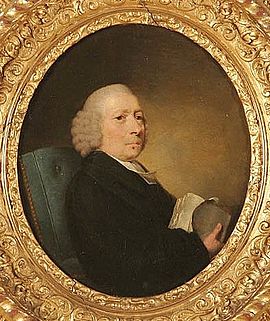Richard Jago facts for kids
Richard Jago (born October 1, 1715 – died May 8, 1781) was an English clergyman and poet. He also enjoyed creating beautiful gardens. Jago came from Warwickshire, a county in England. Even though his writings weren't always highly praised by people at the time, some of his poems were quite new and interesting, inspiring other writers.
Contents
A Look at Richard Jago's Life
Richard Jago was the third son of a church leader, also named Richard, in Beaudesert, Warwickshire. His family had roots in Cornwall, and his mother was from a nearby village. He went to Solihull School, where one of the school's houses is now named after him. There, he became lifelong friends with William Shenstone.
Education and Family Life
In 1732, Richard Jago went to University College, Oxford. His friend Shenstone introduced him to other students who loved literature. Jago finished his master's degree in 1738. A year before that, he had become a clergyman and worked in Snitterfield, Warwickshire.
In 1744, he married Dorothea Susanna Fancourt. She was the daughter of a church leader in Kimcote. Sadly, Dorothea died in 1751, leaving Richard with seven young children to care for. He was later survived by three of his daughters. In 1759, he married Margaret Underwood, but they did not have children together.
Church Work and Hobbies
Jago became the vicar of Harbury in 1746, and soon after, of Chesterton. Thanks to some important people who supported him, he was given the church position in Snitterfield in 1754. Later, in 1771, he also received his first father-in-law's church position in Kimcote. He then left his roles in Harbury and Chesterton. Snitterfield remained his favorite home, and he passed away there at 66 years old.
Richard Jago and his friend Shenstone both loved landscape gardening. Jago spent time making his garden at the Snitterfield vicarage more beautiful. They were part of a group of friends who enjoyed literature, including William Somervile and Richard Graves. Shenstone even dedicated a special bench to Jago in his own famous garden, The Leasowes. They also wrote poems for each other.
Richard Jago's Poetry
Richard Jago's first published works were two sermons. One was for the benefit of a school, and the other was a funeral sermon. He also wrote an essay about electricity in 1747, but it seems it was never published.
Famous Poems and Their Impact
Some of Jago's poems started appearing in books by Robert Dodsley. His emotional poem "The Blackbirds" became quite popular after it was first published in The Adventurer magazine in 1753. This poem was a sad story about a blackbird that sacrificed itself. Soon after, he wrote similar poems about goldfinches and swallows. These poems were praised by Dr. John Aikin, who noted that other poets quickly started writing similar works, like "The Partridges, an elegy" by Samuel Jackson Pratt and "The Linnet" by James Graeme.
Jago's biggest poem was Edge Hill, or the rural prospect delineated and moralised (1767). This long poem described the landscape of Edge Hill in four parts. It was written without rhymes, like a story. The poem mixes descriptions of the scenery with old legends, history, and details about the famous battle that started the English Civil War. Jago also imagined trips to places like Warwick, Coventry, Kenilworth, Solihull, and even industrial Birmingham. He included local rivers and canals, showing boats moving along them.
What Critics Thought
Some critics found Edge Hill interesting because of how carefully Jago described the scene. However, they felt the poem didn't always have the best poetic style. For example, it often used old-fashioned words or phrases, like calling sheep "the woolly tribes." Despite this, the poem seems to have inspired other works, like "Ode to Lansdowne Hill" (1785).
In the year after Edge Hill was published, Jago wrote "Labour and Genius, or the mill-stream and the cascade." This was a funny story in rhyming verse, written to remember his friend William Shenstone and his beautiful gardens.
Later Works and Influence
Other smaller poems by Jago appeared over time. He was working on a new collection of his poems just before he died. This collection, called Poems, Moral and Descriptive, was published in 1784 after his death. It included an oratorio called "Adam, or the fatal disobedience," which was based on Milton's Paradise Lost. Jago wrote the rhyming parts for the choruses.
One of Jago's humorous pieces also inspired another writer. In his poem "Hamlet's soliloquy imitated," a poet wonders whether to publish his poems and risk losing his reputation. A similar funny poem, "The Presbyterian parson's soliloquy," appeared in The Hibernian Magazine in 1774. It was often reprinted and was thought to be inspired by Jago's work. Even though Richard Jago didn't write a huge amount, his poems clearly had an impact on other writers of his time.


